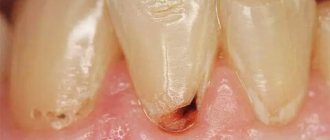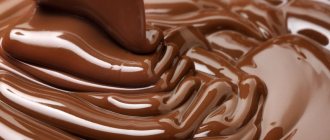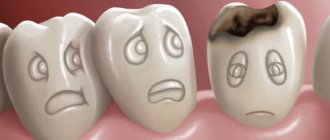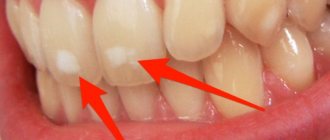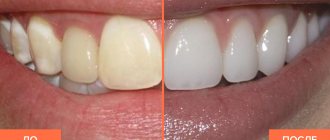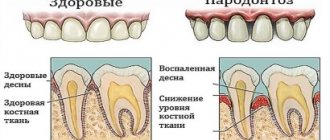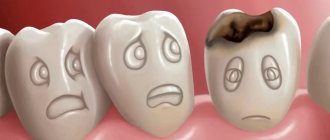Classification of non-carious enamel lesions
The concept of “non-carious lesions” combines many pathologies, each of which is designated in the International Classification of Diseases (ICD 10). Such diseases are usually divided into 2 groups.
- Lesions that occurred before teething (during the period of follicular development of hard tissues, occur in 5-14% of the population):
- hypoplasia – underdevelopment of dental tissues;
- hyperplasia – excessive formation of dental tissue structures;
- endemic fluorosis, or “speckled teeth” - destruction of enamel due to excess fluoride in the body;
- hereditary diseases.
- Lesions that occur after teething (the overall prevalence of such diseases is 50-75%):
- wedge-shaped defect - the appearance of V-shaped defects in the cervical area of the crown;
- erosion - in addition to the enamel, the dentinal layer is destroyed, as a rule, it occurs on the upper incisors and canines;
- pathological abrasion of enamel - intense loss of hard tissue on all or some teeth;
- mechanical injuries to dental crowns – chips, cracks, fractures;
- necrosis (death) of hard dental tissues;
- enamel pigmentation – tetracycline stains, etc.
Non-carious lesions of hard dental tissues: to treat or not to treat?
The loss of dental hard tissues or their abrasion is a process that can be characterized by both physiological and pathological development patterns, which ultimately leads to the formation of non-carious dental lesions. The latter can compromise the aesthetic profile of the smile, disrupt the function of the dentofacial apparatus, provoke sensations of pain and sensitivity, and negatively affect the patient’s quality of life. In the United States, the problem of non-carious dental lesions has not been studied as well as in Europe or Australia, so a unified protocol for their treatment has not yet been developed, which would be based on the available evidence. Overall, the more important question has not even been answered: should such lesions be treated or not?
The structure of the teeth is represented by mineralized tissue, which dynamically undergoes the process of mineralization and demineralization when exposed to oral factors. In the normal state of saliva, calcium and phosphorus ions are washed out to a greater extent from the tooth structure, but when saliva is saturated with fluorides, the reverse process occurs, which ensures homeostasis. Under the influence of chemical and mechanical factors, there is a loss of hard tooth tissue, which can be presented in the form of erosion, abrasion, attrition, abfraction and permanent loss of mineral components by enamel and dentin (photo 1).
Photo 1. Type of physiological tooth wear.
Loss of surface tooth structures due to microbiological activity leads to the development of carious lesions. In turn, the dissolution of mineral components under the influence of chemical agents or chelates from the tooth surface not covered by dental plaque is called erosion. Erosion is not directly related to the action of mechanical or traumatic factors, as well as to carious lesions. However, erosions are often identified together with signs of attrition, abfraction and abrasion. Attrition is the loss of tooth structure due to physical contact between opposing teeth, abrasion is the result of physical abrasion involving abrasive materials, and abfraction is due to tensile and shear stresses, which are usually noted in the cemento-enamel region. If there are signs of several non-carious pathologies at once, it is diagnostically difficult to establish the main cause of the loss of hard tooth tissue.
Classification of non-carious lesions of hard dental tissues
There are four main types of non-carious lesions of hard dental tissues, but in most clinical cases there are signs of several of them at once, which complicates the process of making a final diagnosis.
Erosion
Erosive lesions of the hard tissues of teeth occur due to the effects of acidic or specific erosive factors of the internal or external cut, the intensity of which exceeds the buffering capabilities and neutralizing potential of normal saliva and its proteins. The term “corrosion” also exists to refer to the loss of enamel and dentin tissue as a result of chemical and electrochemical factors. Dental erosion develops when the level of demineralization of calcified hard tissues exceeds the level of remineralization of them. The dissolution of enamel hydroxyapatite crystals occurs at pH 5.2, and of dentin at pH 6.9. Under normal conditions, the tooth structure remineralizes with the formation of hydroxyfluorapatite crystals, which are more resistant to acid. But be that as it may, the duration and frequency of acid exposure determine the risk of developing erosive lesions. Saliva is the most significant biological factor that can prevent the development of erosion. Neurological communication mechanisms stimulate saliva production when oral acidity levels increase, thereby increasing the buffering potential of saliva, dissolving concentrated acids, and maintaining oral homeostasis. The supersaturated concentration of calcium and phosphate in saliva promotes the remineralization of demineralized tooth surfaces. Saliva also plays a role in the formation of the pellicle, which acts as a barrier to protect tooth surfaces. Factors that help prevent erosion also include the tooth structure itself and the position of the tongue. Signs of carious lesions of hard tissues are a decrease in the height of enamel and dentin from the occlusal surface of molars, and the formation of saucer-shaped defects on the tubercles of the latter (perimolysis). With erosion, both minimal signs of damage can be observed, such as loss of shine of the teeth, a dull or matte appearance of the surface, as well as severe symptoms associated with the loss of hard tissues to the level of dentin. As a rule, the width of eroded areas is greater than their depth. When erosive lesions are combined with abrasive ones, the loss of enamel and dentin occurs more quickly and progressively (photos 2-5).
Figure 2: Loss of hard tissue around amalgam restorations.
Photo 3. Appearance of non-carious lesions in patients with GERD.
Photo 4. Combination of erosion and abrasion.
Figure 5. Hard tissue loss and yellow discoloration of teeth in a young patient with GERD.
Abrasion
Abrasion is the loss of hard tooth tissue due to friction (exposure) to abrasive agents. Such lesions occur when toothpaste and brushes are used incorrectly. The severity of abrasion depends on the level of abrasiveness of the active agent, the magnitude of the acting force, the time of exposure, and the frequency of development of physical contact (photo 6). Abrasives in the structure of toothpastes include silicates, aluminum, calcium phosphates and calcium carbonates. Typically, the abrasive changes caused by brushing are minimal, but this depends on the type of brush used and the concentration of abrasive in the toothpaste. The abrasiveness of the toothpaste suspension affects the level of hard tissue loss, therefore, the composition of the toothpaste must be taken into account when choosing it before use. However, some studies found no correlation between the composition of toothpaste and the development of cervical lesions of the teeth. Abrasive lesions are characterized by a larger axial depth parameter than the occlusal-gingival width, and sharp angles are often noted in their geometric structure.
Photo 6. Erosion and abfraction in a patient with xerostomia in a photo of Sjögren's syndrome.
Attricia
Attrition is the loss of dental hard tissue due to mechanical contact with opposing teeth, or with restorations on opposing teeth. When occlusal relationships are violated, signs of attrition become visible on natural teeth that interact occlusally with restorations, since the latter are harder than the structure of intact enamel and dentin. Often, signs of attrition are most pronounced in the area of occlusal and contact surfaces, as well as in the projection of the cutting edge of the teeth. The severity of attrition is influenced by the type of chewing, swallowing and the presence of parafunctional activity. In the absence of control of these factors, abrasion facets develop in the enamel projection, which have a flat and clearly defined shape on both antagonist teeth (photo 7).
Photo 7. Metal-ceramic structures that antagonize the patient’s own teeth.
Abfraction
Abfraction is the result of static and cyclic loading, which develops due to the action of various biomechanical forces on the tooth structure. The effects of biomechanical forces that act on the weakest part of the tooth, that is, the cemento-enamel junction (CEJ), depend on the magnitude, duration, direction, frequency and location of the forces. As a result, the enamel or dentin can chip, forming non-carious lesions in the neck of the tooth. The latter are characterized by a specific V-shape (photo 8). Most data on abfraction are based on “engineering” models of studying the tooth, or separately its coronal and root parts. However, more in-depth studies of the function and interaction of the periodontal ligament and alveolar bone have called into question the fundamental theoretical basis of the theory of abfraction development associated with the influence of biomechanical components.
Photo 8. V-shaped cervical defects of teeth as a result of occlusal overload.
Common causes of the development of non-carious lesions of hard dental tissues
Bruxism / clenching
Bruxism is a pathological habit of non-functional clenching and further movement of the jaw (parafunction) into an eccentric position, which includes the canine and incisal routes of insertion. Bruxism is associated with significant hard tissue loss (three to four times the normal rate of wear ranging from 10 to 20 µm per year), which leads to structural changes in tooth morphology with the formation of deep grooves and wear facets. Clanching is considered a “silent form of bruxism” in central occlusion without lateral or protrusive movements of the jaw. The loss of hard tissue in the area of the anterior teeth is much more pronounced than in the area of the distal teeth.
Pathology
Diseases that provoke the loss of hard tooth tissues include pathologies associated with disruption of the natural process of formation of enamel and dentin (impaired emalogenesis, impaired dentinogenesis). With a decrease in the mineral density of the tooth, the level of mineralization and hardness of the structure, the teeth become less resistant to the effects of physical and chemical factors. In addition, the level of oral defense reactions decreases when the normal function of saliva is disrupted due to its deficiency or dysfunction of the salivary glands. These conditions are associated with such general somatic pathologies as Schoengren's syndrome, rheumatoid arthritis, as well as with radiation therapy in the head and neck area. With hypofunction of the salivary glands, there is a deficiency of saliva, which in turn provokes an increase in the level of friction between the teeth, as well as between the teeth and the toothbrush. Locally specific loss of hard dental tissues is a protective mechanism, or a compensatory effect of the structures of the dentofacial apparatus. Gastroesophageal reflux disease (GERD) also has a negative effect on the structures of hard tissues, due to which the pH of the oral cavity is significantly reduced, which leads to the dissolution of mineral components in the tooth structure. Tooth erosion can be considered an atypical symptom of GERD. Voluntary regurgitation is also observed in cases of anorexia nervosa and bulimia, which similarly leads to acid damage to the teeth. Various medications with anticholinergic side effects (eg, psychiatric medications, antihypertensives, drug combinations, etc.) cause decreased salivary flow. Chronic use of drugs with low pH (solutions, chewable tablets or inhalations) has a detrimental effect on teeth and can potentially provoke the development of erosive lesions of enamel and dentin.
Diet and lifestyle
Frequent consumption of acids, especially citric and acetic acids in various drinks and foods, provokes the dissolution of minerals in the structure of teeth and reduces their microhardness. pH is not the only parameter influencing the resistance of hard dental tissues. The integrity of enamel and dentin structure is also dependent on the erosive potential of foods and beverages, the buffering properties of saliva, and the calcium chelation pattern recorded with different types of diet. Foods and drinks containing citric acid are characterized by a more pronounced erosive effect than those containing phosphoric acid. Diet drinks that are low in calories and sugar do not actually provide adequate caries prevention because their erosive potential causes the hard structures of enamel and dentin to dissolve and thus increase their susceptibility to bacterial attack. A high risk of damage to hard tissues is characterized by the consumption of “sports” drinks with a high level of acidity (pH = 3), especially immediately after sports in conditions of dehydration of the oral cavity. On the other hand, consuming hard foods that require careful chewing also increases the risk of developing pathological loss of hard dental tissue. Personal habits such as smoking a pipe, chewing a pen or pencil, or opening bottles with teeth also provoke the development of non-carious lesions. Working under conditions of constant stress, in factories with a high level of air acidity, in noisy conditions, swimming in chlorinated pools, professional wine tasting, and playing certain musical instruments are all factors in the medical history that can negatively affect the condition of the structures of the hard tissues of teeth. .
Brushing teeth and toothpastes
Brushing teeth that are in a demineralized state after exposure to acid causes a cumulative effect of loss of hard enamel and dentin tissue. Brushing teeth in a horizontal direction causes more wear on the cervical portion of the tooth compared to a vertical brushing pattern. In addition, the type of bristles of the toothbrush, as well as the type of toothpaste used, have a pronounced mechanical effect on the surface of the teeth. More pointed filaments of a toothbrush, a larger number of tufts, their dense arrangement and stretching under load are the factors that most likely negatively affect the abrasion of hard dental tissues and restorative materials. A certain level of abrasiveness in toothpaste is necessary to effectively remove bacterial biofilm and stains from accessible tooth surfaces, as well as to polish them during the brushing process. However, the levels of abrasiveness of toothpaste, determined by the RDA and REA methods, are significantly associated with the risk of abrasion of tooth surfaces, therefore, these indicators must be paid attention to when choosing a toothpaste. Interestingly, at the legislative level, RDA indicators may not be indicated on the product packaging; in this case, it is better to check the exact parameters on the manufacturer’s website.
Craniofacial complex
Vertical deviations, a small angle between the mandibular and palatal planes, as well as a small angle of the lower jaw can affect the level of abrasion of tooth surfaces. The forces and tensions that develop during chewing can reach quite high values, since the masticatory muscle, responsible for their development, is one of the strongest in the human body. The more square the patient's face looks, the larger the area of attachment of the masticatory muscles, which means the greater the bite force and pressure. It is logical that with stronger biting, the risk of pathological loss of hard tissue increases markedly.
Iatrogenic dental causes
In cases where the hardness of restorations or crowns exceeds the hardness of their own antagonist teeth, signs of pathological abrasion begin to develop in the area of the latter. To avoid these, it is necessary to carefully monitor the levels of occlusal relationships. Typically, problems with pathological abrasion of teeth are localized and projected onto teeth that antagonize different types of orthopedic structures, although in some cases they can also be generalized.
Aging
Abrasion of hard dental tissues occurs physiologically and with age. During the functioning of the teeth, the tubercles are smoothed out, wear facets are formed, the volume of enamel decreases and the dentin surface is exposed. As the life expectancy of the population increases, the period of dental function also increases, which is why the prevalence of gum recession is increasing, exposing areas that are normally located below the level of the gums. Among older patients, whose teeth have been functioning for a longer period of time, the risk of developing erosive non-carious lesions increases against the background of the development of recessions.
Consequences of non-carious lesions
The consequences of non-carious lesions depend on the degree of clinical severity of such lesions. Firstly, it is possible to lose the entire enamel structure with exposure of the dentin surface, changes in the transparency of the tooth and yellowing of its structure. Secondly, wear facets may form on the occlusal surfaces and flattening of the cusps may be noted. When the dentin surface is exposed, patients often complain of hypersensitivity, but in some patients, on the contrary, sclerosis of dentin and its tertiary deposition develop, therefore, there are no signs of hypersensitivity. A decrease in the height of clinical crowns due to pathological abrasion is also fraught with a reduction in the height of the bite, which negatively affects the function of the temporomandibular joint. Progressive pathological tooth wear is also associated with the risk of developing pulpal lesions, and in the frontal areas - with a compromise in the external profile of the smile. It is logical that in such conditions, patients want to restore the natural appearance of their teeth and solve existing functional problems on the part of the dentofacial apparatus, and all this entails a set of financial costs. Thus, non-carious dental lesions are associated with a violation of the parameters of function and aesthetics, and, accordingly, with a decrease in the overall quality of life of patients.
Treatment
Treatment of non-carious lesions of teeth should be comprehensive and take into account the action of the main etiological factors. A simply restorative approach to restoring lost tissue without taking into account the root causes of the damage is often unsuccessful. So far, no evidence-based recommendations have been developed regarding the prevention of the development of non-carious pathologies of hard dental tissues. But the dentist must be well aware of the reasons for their development in order to inform the patient about all treatment options, its prognosis and features.
Preventive methods
To assess the effectiveness of preventive programs aimed at preventing the development of non-carious lesions of enamel and dentin, it is necessary to record the condition of teeth using special cards, photo registration, surface mapping and model analysis. It is primarily recommended to gradate the level of severity of pathological abrasion. According to the Tooth Wear Index 0, the level of hard tissue loss corresponds to a stable state of enamel characteristics (B/L/O/I) and an integral tooth contour (C); Level 1 – loss of enamel characteristics (B/L/O) and minimal loss of tooth contour (C); Level 2 – loss of enamel and dentin exposure on one third of the tooth surface (B/L/O), or loss of enamel with minimal dentin exposure (I), or a contour defect up to 1 mm deep (C); Level 3 - loss of enamel and dentin exposure of more than one third of the tooth surface (B/L/O), or loss of enamel with significant dentin exposure (I), or a contour defect 1-2 mm deep (C); Level 4 – complete loss of enamel, exposure of pulp or secondary dentin (B/L/O), or exposure of pulp and secondary dentin (I), or contour defect more than 2 mm deep (C). According to another classification, class I of non-carious pathologies includes vestibular lesions in the early stages of erosion with the absence of obvious contour changes, a smooth shiny surface mainly on the labial side of the upper incisors and canines. Class II lesions involve the involvement of dentin at 1/3 of its depth (type 1: ovoid or cup-shaped lesions of the cervical areas, which must be differentiated from wedge-shaped defects; type 2: uneven lesions of the entire crown). Class IIIa lesions include those with more extensive destruction of dentin, especially in the area of the anterior teeth, and the lesions themselves are characterized by a fairly large area; at the same time, class IIIb lesions extend to the lingual surfaces and cutting edge, and the lesions themselves are characterized by the presence of smooth dentin. In class IIIc, the cutting edges and occlusal surfaces are affected down to the dentin levels and become flattened; existing restorations may even protrude somewhat above the level of their own tissues; the cutting edges appear overly transparent. Class IIId lesions characterize pronounced disturbances in the structure of the teeth on both the vestibular and lingual sides.
By monitoring changes in the lesion according to the classifications described above, it will be possible to monitor how effective a particular method of prevention and treatment of non-carious pathologies is. In addition, it is necessary to pay sufficient attention to general somatic pathologies that may be associated with loss of enamel and dentin of non-carious etiology (GERD, diseases of the salivary glands, chronic renal failure). If there is a deficiency of saliva, you can use special stimulating drugs (pilocarpine HCl or cevimeline HCl). In cases of xerostomia developing while taking certain medications, they should be replaced with others with a less pronounced indirect cariogenic effect. Diet is also an important component of the prevention program. Patients should keep a food diary for a week and review it to minimize the intake of acidic foods and switch to less acidic foods fortified with fluoride and minerals such as calcium and phosphate. It is also recommended to eat neutralizing foods, such as cheese. To normalize pH levels after meals, it is advisable to rinse your mouth with plain water, a low-fluoride mouthwash, milk, or baking soda (sodium bicarbonate). At the same time, you should not start brushing your teeth immediately after first eating acid-containing foods; first, it is better to rinse your mouth in order to normalize the pH. It is also recommended to use less toothpaste and toothpastes with low relative abrasiveness in general. Patients should also be told about the possibilities of modifying their brushing technique to use less force and the benefits of using brushes with rounded bristles. In the presence of bruxism, the treatment protocol becomes more complicated, and it should, among other things, include changing some behavioral aspects and habits, such as, for example, correcting the influence of stress factors, studying relaxation therapy methods (yoga, self-relaxation, self-hypnosis). In certain cases, the doctor may prescribe the use of a mouthguard to mechanically separate the tooth at night or during the day.
Remineralization of tooth structure
Every effort should be made to ensure effective remineralization of the tooth structure and to minimize the progression of hard tissue loss of enamel and dentin. Fluoride promotes the reuptake of available calcium and phosphate present in saliva. However, fluorides are available in various concentrations and can be used by the patient, for example, in the form of sodium fluoride (in the form of toothpaste with a concentration of 5000 ppm), or applied to the teeth by the dentist during a visit (in the form of varnish with a concentration of 26,000 ppm). Mineral reuptake can be improved by adding or using calcium and phosphate ions in various forms along with fluoride. In turn, fluorides, sodium hexametaphosphates, ferrous sulfate and fluorinated tin rinses also act as anti-erosion agents.
Dental restoration
Physiological tooth wear does not always require treatment. However, if the process of hard tissue loss is pathological, then the patient should be given appropriate treatment. Active treatment depends on the individual characteristics and needs of the patient, the extent of the lesion, the skill of the dentist, time available and cost. Evidence based on dental analysis in accordance with generally accepted engineering principles indicates that non-carious lesions should be restored. To do this, it is first necessary to ensure control over the etiological factors to ensure the success of all subsequent manipulations. Restoration of cervical non-carious defects requires special attention, taking into account the development of all forms of stress that develop in the tooth during occlusal interaction. When restoring cervical defects, the amount of preparation should be kept to a minimum to ensure only the roughness of the affected surfaces. The most common cause of unsuccessful restoration of cervical non-carious defects is microleakage. In this case, it is advisable to carry out restorations only when the positions of central occlusion and the central ratio have converged into one spatial position, or when a state of compensation has been achieved in the structure of the dentofacial apparatus. Restorations for non-carious lesions include those with overlapping tooth surfaces with composite material using the sandwich technique, as well as designs of metal, metal-ceramic and ceramic crowns (photo 9-16).
Photo 9. Non-carious lesions of teeth according to class 5.
Photo 10. Type of non-carious lesions of class 5 restored using composite restorations.
Photo 11. Compromise of the aesthetic appearance of teeth as a result of pathological abrasion.
Photo 12. View of the patient’s teeth after restorations have been completed.
Photo 13. Compromised aesthetic appearance of teeth due to pathological abrasion.
Photo 14. View of the patient after rehabilitation with metal-ceramic structures.
Photo 15. Type of non-carious dental lesions in a patient with bulimia.
Photo 16. Restoration of defective areas with composite restorations.
If the central occlusion does not correspond to the centric relation, and there are signs of localized pathological abrasion in the area of the lower anterior teeth, it is first necessary to ensure careful monitoring of the condition of the dentofacial apparatus. If signs of localized pathological abrasion are visualized in the area of the upper teeth, restorations can be performed and a Dahl device can be used. The latter is a metal bite plate, which is used to restore areas of teeth affected by pathological abrasion by forming the necessary interocclusal space. When the intermaxillary space increases due to loss of bite height, it is first necessary to establish the position of the central relationship, and only then proceed to dental restorations. When the vertical height of the bite increases, it is recommended to use stabilizing mouth guards. If the patient can normally tolerate the height of the aligner, then in such cases restorations can begin; If the patient cannot tolerate the height of the aligner, then the clinician should consider using an approach of lengthening the height of the clinical crown.
conclusions
Pathological abrasion of teeth and associated non-carious lesions of enamel and dentin are pathologies that are difficult to objectively diagnose with verification of the main cause of the disorders. The etiology of noncarious lesions is individual in each individual clinical situation, and the signs of this disorder vary between patients in terms of both patterns and types of hard tissue loss (erosion, attrition, abrasion, abfraction, or a combination of these). To ensure a successful outcome in the treatment of pathological abrasion, the doctor must take into account the etiology of such, the possibility of implementing preventive approaches and targeted therapeutic interventions, based on the conditions of each individual clinical case.
Authors: Mabi L. Singh, DMD, MS Gerard Kugel, DMD, MS, PhD Athena Papas DMD, PhD Britta Magnuson
Why is tooth enamel destroyed?
The etymology of non-carious enamel lesions is still controversial. Since bacterial infection and inflammation are absent, then the cause of tooth decay is a combination of external and internal unfavorable factors.
External reasons:
- bruxism (involuntary grinding of teeth at night);
- eating too hard food;
- using a toothbrush with hard bristles, as well as excessively intense movements when brushing your teeth;
- malocclusion;
- consumption of foods high in acids (citrus fruits, berries, carbonated drinks, wine).
Internal reasons:
- diseases of the kidneys, gastrointestinal tract, cardiovascular system;
- endocrine disorders;
- deficiency of calcium and other important elements in the body.
Causes of acid enamel erosion:
Food preferences
In more than 40% of patients with acid erosion, the cause of the disease lies in dietary habits. There are many acids in food and drinks: fruits (especially citrus fruits) and berries, and fruit juices contain citric acid. Sweet soft drinks, carbonated drinks and wine are also saturated with acids.
Interestingly, patients with erosive enamel defects often adhere to a healthy lifestyle and are careful in their food choices. Can you imagine the acid attack the enamel takes if a person follows the “healthy” recommendation to drink water with lemon as often as possible? Abuse of water with lemon juice affects not only the enamel, but also the entire gastrointestinal tract.
Food preferences
According to the latest scientific data, the abundance of fresh fruits and vegetables in the human diet is associated with the appearance of acid erosion on tooth enamel. Therefore, vegetarians, vegans and all adherents of “healthy nutrition” are at risk.
The problem of acid erosion has become especially relevant in recent decades due to the increase in the amount of acidic foods and drinks in the diet. The lifestyle of a modern person is often determined by advertising and fashion trends. The average American resident's consumption of carbonated soft drinks (Coca Cola, Fanta, Sprite) has increased by 300% over the past 20 years! An equally shocking nutritional statistic: serving sizes increased from 185g in the 1950s to 570g by the late 1990s. Just think, back in 1995, up to 85% of children in school in the United States drank at least one carbonated drink per day. The situation in the USSR and post-Soviet countries was little better. It turns out that you need to give up fruits and juices altogether? No, but it’s worth sensibly assessing the amount of acid-containing foods in your diet and taking them under observation. After eating acidic foods, you can rinse your mouth with water. It is recommended to drink juices and water with lemon through a straw.
Stomach problems
Acid can get on teeth not only from the outside, but also from the inside. A symptom of a number of problems with the gastrointestinal tract is the so-called regurgitation. In simple terms, this is the reflux of stomach contents back into the oral cavity. Typically, this condition is not associated with nausea, vomiting, or contractions of the smooth muscles of the stomach.
Stomach problems
The occurrence of regurgitation is dangerous because gastric juice contains hydrochloric acid - it promotes the breakdown of food and maintains the required level of acidity in the stomach. However, when it gets on the surface of the teeth, hydrochloric acid destroys the enamel structure and causes erosion on the inner surface of the teeth.
Regurgitation can be not only a symptom of a disease, but also an involuntary physiological phenomenon. In psychiatric diseases such as anorexia nervosa or bulimia, the patient may induce vomiting and provoke regurgitation.
Environment at work and at home
Mention should be made of workers in hazardous industries. Acid fumes in production (for example, in battery factories) expose human teeth to constant acid attack. It is not surprising that acidic erosion of the enamel occurs as a result. Fortunately, the percentage of such situations is small.
Swimming pool enthusiasts and professional swimmers should also take control of the condition of their enamel and carry out supportive therapy, because their teeth receive an acid load from chlorinated water and its vapors.
Non-carious lesions of teeth in children
Non-carious lesions in children most often belong to group I, that is, tooth germs are destroyed or completely die at the development stage (the period of intrauterine life of the child).
This may occur due to genetic disorders, toxic effects of medications taken by the expectant mother, as well as intrauterine infections. Excess or deficiency of vitamin D, as well as excessive fluoride concentrations, also have a detrimental effect.
Early toxicosis of a woman during pregnancy can also disrupt the mineralization of a child’s teeth.
Types of damage to tooth enamel before teething
Dysplasia
A number of disorders, which is characterized by a number of signs: gray spots, thinning of the enamel or the absence of fragments of the enamel layer. In the vast majority of cases, dysplasia is associated with genetic abnormalities, metabolic disorders and bone diseases. When teething, teeth may be irregular in shape (triangular, pear-shaped, etc.).
To treat erosion of tooth enamel, multivitamins, sodium fluoride, and electrophoresis are prescribed. In case of extensive lesions, artistic restoration and prosthetics are used to restore aesthetics. To avoid complications, dental enamel dysplasia in children requires immediate treatment.
Hypoplasia
With hypoplasia, atrophy of tooth tissue or its complete absence is observed at the intrauterine level. Usually the disease is associated with a mineral imbalance. Hypoplasia is expressed by a change in color (to gray or brown), the appearance of spots, thinning of the enamel and even its complete absence (aplasia).
When treating thinning enamel, medications are prescribed to restore mineral balance (calcium gluconate solution, etc.), as well as a complex of vitamins. In case of aesthetic problems, whitening can be performed, and in severe cases, the tooth is covered with a crown or veneer.
Hyperplasia
Excess dental tissue, the appearance of which is also caused by an imbalance of mineral balance (usually due to hormonal imbalances in parents or blood diseases). On the surface of the tooth, so-called enamel drops are formed - islands of brown or reddish color. For more complex anomalies, hypertrophied areas can be filled with dentin or pulp.
Treatment of hyperplasia includes polishing teeth with a drill, applications and rinsing with fluoride and calcium solutions in combination with taking medications that normalize the mineral composition and eliminate the root cause of the deviation.
Fluorosis
When dental fluorosis occurs, spots, grooves, pits, or streaks form on the surface of the enamel. The disease is caused by an excess of fluoride in the body and often occurs in children.
Remineralization of enamel, grinding of teeth, and normalization of the amount of fluoride in the body are indicated. In difficult cases - orthopedic treatment and artistic restoration.
Changes in the structure and violation of the integrity of the enamel can be caused by a number of genetic abnormalities and hereditary diseases. That is why it is important to establish the root cause so that the best treatment can be prescribed if tooth enamel is damaged or atrophied.
Diagnosis of non-carious lesions
The main signs of destruction of dental tissues:
- change in enamel color;
- change in the structure of the tooth surface, which becomes wavy, dotted or grooved;
- visual reduction of the coronal part, formation of round defects with a diameter of up to 5 mm.
Also, one of the main symptoms is increased sensitivity of the enamel (hyperesthesia). In the first stages, a reaction to hot and cold food appears; over time, pain arises from chemical irritants (sour, sweet, salty) and the slightest tactile influence.
Classification and diagnosis
Depending on the causes of the development of problems, the following types of disease are distinguished:
- household (improper diet, taking certain medications, gastrointestinal diseases, unfavorable environment);
- professional (develops under negative conditions in industrial premises).
According to the degree of severity, they are distinguished:
- first - only the enamel is affected;
- second – the lesion concerns the dentin;
- third – secondary dentin is formed;
- fourth - necrosis of pulp tissue, the appearance of inflammatory processes, pain.
When diagnosing, it is important to distinguish necrosis from similar problems such as multiple caries, hypoplasia, fluorosis, and amelogenesis imperfecta. They all have some similar characteristics, such as rough enamel or pigmentation. But when exposed to acidic vapors or substances, the intensity is higher, progression is observed, a decrease in the level of occlusion and severe abrasion.
Treatment and prevention of non-carious diseases
Prevention of non-carious enamel lesions includes increasing the body's protective functions and strengthening the dental structure. For this, vitamin therapy (vitamin A, C, E, B6) and medications with microelements (magnesium, zinc, etc.) are prescribed. It is important to include foods rich in calcium and protein in your diet.
An integral part of the therapy is enamel remineralization. In the initial stages of the disease, you can use homemade gels and pastes containing fluoride - “ROCS”, “Splat” and others. At later stages, deep fluoridation in the dentist's office is recommended.
In the presence of significant deformations, filling is performed with ionomer cements with minimal preparation or photopolymer composites. You can restore the anatomical shape of your teeth and prevent their further destruction with the help of ceramic veneers and crowns.
The sooner you see a dentist, the easier it will be to stop the disease. You can find a list of specialized dentists on our website.
I. Disorders of teeth eruption and their further development
Disorders of tooth formation - Turner's tooth, neonatal and prenatal hypoplasia.- Anomalies in the shape and size of teeth - bifurcation, fusion and fusion of teeth, dental invagination (tooth in tooth), enamel pearls.
- Mottled teeth – fluorous (endemic) mottled enamel.
- Manifestations of congenital late syphilis are molars in the shape of mulberries, Hutchinson's teeth.
- Violations of the structure of teeth of a hereditary nature - imperfect dentino- and amelogenesis, changes in teeth with osteogenesis imperfecta.
- Other developmental disorders of teeth are color distortion during their formation as a result of a congenital malformation of the biliary system, incompatibility of fetal and maternal blood groups, use of tetracycline, porphyria.
Causes of the disease
The causes of necrosis include:
- the external unfavorable environment in which a person lives;
- internal disorders in the body, leading to a decrease in immunity, which in turn affects the teeth.
- taking certain types of medications.
External exogenous factors include working in hazardous industries, where the air is filled with toxic substances or the level of radiation is increased. In hazardous industries, toxic substances enter the oral cavity with the air, most often affecting the front teeth, fangs, and less often molars. The main function of saliva is disrupted, salivation decreases, and there is a negative effect on the microcirculation of blood vessels inside the tooth, which in turn impairs the supply of oxygen to the tooth. The natural regeneration of the enamel layer and dentin is hampered, the walls of the tooth become thinner, and the tooth wears down and decays naturally.
Internal, endogenous causes include diseases of the endocrine gland, disorders of the central nervous system, diseases of the gastrointestinal tract, and reduced immunity. Making a diagnosis involves examining the entire body to identify a disease of a specific organ that affects tooth decay.
Symptoms
As necrosis progresses, symptoms may vary. At the beginning of the disease, the teeth simply change their color, spots appear on the surface of different colors: white, gray or even black, this largely depends on the effect of a certain chemical. Further, the enamel becomes thinner or completely destroyed, breaking off in parts, and the teeth acquire a rough surface. Due to the lack of a protective enamel layer, teeth become extremely sensitive to cold, hot, and sour, and brushing your teeth becomes painful. A feeling of viscosity appears in the mouth, like after eating persimmon.
The disease develops quickly, without taking appropriate measures, the teeth begin to wear down and become thinner. The functional efficiency of teeth decreases.
Diagnostics
Diagnosis of the disease involves excluding other non-carious tooth decay, such as a wedge-shaped defect or enamel erosion. Necrosis differs from other non-carious diseases by the lack of shine on the teeth. To exclude necrosis in the invisible, hidden parts of the tooth, X-ray diagnostics are performed.
In addition to examining the teeth, it is also necessary to find out the main cause of necrosis. This may require consultation with a gastroenterologist, endocrinologist, immunologist and other specialists.
Acid necrosis of teeth
Acid necrosis of hard dental tissues is an occupational disease that occurs in people working in the production of inorganic acids. It is assumed that acid vapors reduce the pH of saliva, and the capacity of the buffer systems of the oral fluid and the remineralizing properties of saliva are also reduced. This contributes to rapid wear (abrasion) of the hard tissues of the tooth. Dental damage is widespread and the process develops slowly.
Clinical picture
Acid necrosis of teeth develops slowly. With chemical necrosis, fangs and incisors are more often affected: in the area of the cutting edges, the enamel disappears, resulting in the formation of sharp edges. In the initial stage, patients have a feeling of teeth on edge, and there may also be a feeling of teeth sticking, which is associated with the “washing out” of minerals from the tooth enamel, resulting in a feeling of softness of the teeth when they are closed. In later stages of the disease, pain from temperature and chemical stimuli appears. However, it should be borne in mind that pain may not be observed, due to the fact that tertiary dentin is being produced. As necrosis progresses, the enamel loses its shine, becomes dull and rough. And after complete loss of enamel, dentin becomes pigmented and becomes dark. In advanced cases, complete dissolution and abrasion of the tooth crown may occur.
Differential diagnosis of acid necrosis
Acid necrosis of teeth must be differentiated from enamel erosion. Erosion is characterized by a hard, shiny surface, and with necrosis, softening of the enamel occurs.
Prevention of acid necrosis
Prevention
acid necrosis is to improve working conditions, use individual products, and conduct regular alkaline rinses.
Symptoms of tooth erosion
In the initial stage, there is a loss of enamel shine in a limited area of the vestibular surface of the tooth. At this stage, you can notice signs of the beginning of the erosive process only after drying the tooth surface with a stream of air or applying 5% iodine tincture to the affected area - in this case, a yellow-brown coloration of the erosion area occurs.
Initially, the erosive defect is a round or oval cup-shaped lesion with a hard, smooth and shiny bottom. As the lesion expands and deepens, complete loss of the enamel layer and exposure of dentin may occur. With I and II degrees of tooth erosion, the defect has a whitish color; at stage III of the pathological process, light yellow or brown pigmentation appears.
At the initial stage of tooth erosion, with a stabilized course, there is no pain. In the active phase, with moderate and deep degrees, phenomena of hyperesthesia are observed when brushing teeth, the action of chemical and thermal irritants. The most common lesions are symmetrical incisors, canines and premolars. Erosion of enamel is often combined with pathological abrasion of hard dental tissues. The course of dental erosion is chronic, progressive, characterized by gradual damage to new teeth.

